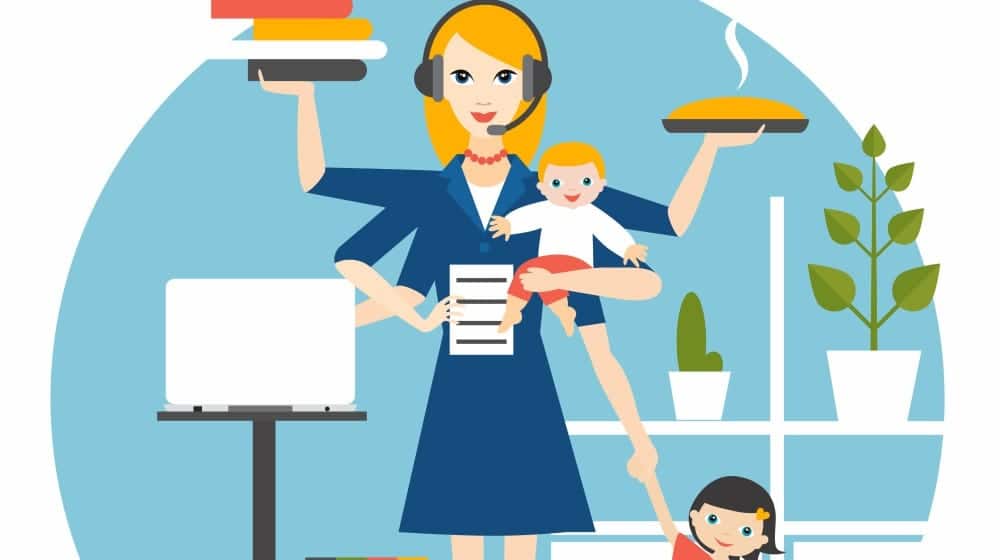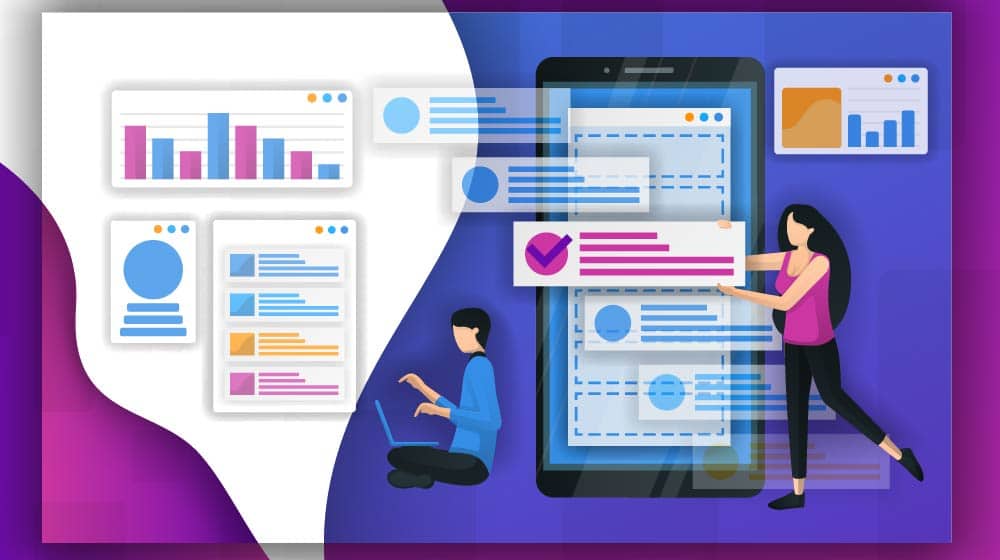How To Multitask As A Work From Home Parent: 7 Simple Ways

Learning how to multitask can provide an extra productivity boost as a work-from-home parent. Learn five practical
ways you can do it in today’s article.
RELATED: How To Work From Home With Kids
In this article:
- Focus on One Thing at a Time
- Segment Your Tasks
- “Multi Tasking” With the Pomodoro Technique
- Multitasking at Work With the Right Combinations
- Distinguish Multitasking Tasks From Those That Require Pure Focus
- Minimize Distractions
- Plan Ahead
How to Multitask Effectively If You Work From Home: 7 Practical Ways
Focus on One Thing at a Time
While there are positive effects of multitasking, there are also some downsides to it that any work-from-home parent needs to take note of. If you want to be a
successful multitasker, control the situation rather than let it control you.
Doing multiple things simultaneously can become counterproductive because each task only gets a fraction of your
attention and effort. Here are two task management strategies you can try to ensure productivity even if you have
multiple tasks:
- Work on one task at a time, and don’t stop until you’ve finished it. Whether it’s something for work or
something for your family, finish it before moving on to the next task. - You can also try getting easier tasks out of the way first before you switch to more difficult tasks.
Segment Your Tasks
Even true multitasking doesn’t usually mean literally doing two things at the
same time, like you do when you’re browsing the net on your phone while watching TV. Instead, it’s more like
breaking your larger task up into small parts so you can have multiple works in progress at the same
time.
Before you begin a task, you should examine it and decide all the parts of it
that can be done separately. Doing so will allow you to sprinkle manageable bits of the task into your busy
routine without forcing it to take up too much of your time. It will of course take you longer than if you
focus on the task exclusively, but completing it will feel much more effortless.
“Multi-Tasking” With the Pomodoro Technique

For serial multitaskers who want to settle for a compromise, the Pomodoro Technique can help.
In this technique, one “work cycle” refers to 25 minutes of straight, uninterrupted work followed by a five-minute
break. On every 4th work cycle, the mandatory break extends to 10 minutes.
The principle behind the Pomodoro Technique is, by working in periodic bursts of intense focus with short but
frequent breaks, one can preserve brainpower, and extend mental performance and productivity. By taking breaks
before even feeling mental fatigue, you can optimize mental recovery and productive times.
Here’s an example of how can you apply it at home:
- Write an article during the first work cycle. Take the five-minute compulsory break at the end.
- Prepare breakfast for the family during the second work cycle, capped off with another mandatory five-minute
break. - Go back to writing the unfinished article for the third work cycle, again, ending it with a five-minute break.
- Wash the breakfast dishes during the fourth work cycle, extending the mandatory break to 10 minutes.
This isn’t full-blown multitasking, but it gives a person just enough time to work on multiple tasks exclusively.
RELATED: How To Work Smarter Not Harder To Get More Done
Multitasking at Work with the Right Combinations
Throughout the day, you’ll encounter tasks of varying difficulties, both physically and mentally, and focus
requirements. Choosing the right combinations of these tasks can help preserve your physical and cognitive energy.
Nir Eyal, the author of the bestselling book Indistractable, says a combination must only have one task that
needs focused attention. Here are some examples:
- Listening to an audiobook while walking around a park, which doesn’t require task switching. Walking’s an
activity that requires little or no focused attention at all, save for when crossing a street, and can be paired
with listening to an audiobook. - Another example is thinking of a solution to a work problem while taking a shower. Thinking of a solution is the
only activity that requires focus and one that doesn’t involve mental switching.
Aside from the focus they require, these tasks also have another thing in common — they combine a task that requires
physical effort with another that requires mental effort. The ideal combination of beneficial
multitasking is this: a mental task and a simple physical task.
Distinguish Multitasking Tasks from Those That Require Pure Focus

While multitasking can work with the right combinations, some activities require complete focus and undivided
attention. These are high-stakes tasks that have little to no room for error.
A good example of this is driving. Driving is both a mental and a physical task with little or no room for error.
How many serious or fatal vehicular accidents happened because the driver’s ability to concentrate was compromised by
texting or browsing social media while driving? In cases like these, all distractions must be avoided because they
can be life-threatening.
Listening to music, on the other hand, is one of those “gray area” activities. Whether
it’s a multitaskable task or not depends on why a person is doing it.
- If a person’s listening to music to study a part in a band or musical, it shouldn’t be multitasked.
- If it’s for pleasure, then that person can do it while doing other tasks like washing a car or reading a book.
The most important, non-multitaskable activity you should prioritize is spending quality time with family.
Multitasking people should never compromise on this.
Establish clear boundaries between work and family. If it’s family time, focus only on your family. If you weren’t
able to do something before family time, remind yourself there’s tomorrow to finish it instead of feeling guilty
about it.
When multitasking, people give their undivided attention to their spouse and kids, emotional needs are met. When this
happens, the chances of their kids and spouses interrupting them, especially while multitasking, can be minimized.
Minimize Distractions
Multitasking already stretches your attention very thin. Even small distractions can
make your job a lot harder if they are thrown into the mix.
In 2020, there are so many things that can distract you at all times of day as a work
from home parent: family members, chores, cell phones, and social media accounts, just to name a few. Even small
noises in your environment can put a big damper on effective multitasking.
A few tips for those looking to multitask with as little distraction as possible
include:
- Buy a pair of high quality noise canceling headphones.
Make sure to get a pair with active
noise reduction, the feature that produces “negative white
noise.” They’re not cheap, but they’re worth it. Some people focus best by wearing such headphones without
actually listening to any music through them, while others are good at multitasking while listening to
ambient music. - Multitask in a room with a closing door. The physical
barrier will obviously keep people from distracting you, but it will also help create a mental impression
that you are in an actual workspace rather than your house. - Close your social media. You may want to go one more
step by logging out of your accounts. Doing so will prevent you from quickly opening a new Facebook or Gmail
tab to check if you have new notifications, which is just another way of looking for an excuse to get
distracted.
Plan Ahead
Planning ahead is a good habit that can help you multitask better and stay organized when you work from home. Having a schedule and a
to-do list can help you utilize the tips above.
- You can figure out which mental and physical tasks to combine at a certain time.
- If you’re using the Pomodoro Technique, you can also schedule your day around your work cycles.
- You can also set a specific time block reserved for family time ahead of time. In this way, you know exactly
when you have to stop working and focus on your loved ones.
Planning one’s schedule for the weekends is an ideal way to plan ahead. That person can lump together related
activities that can either be done simultaneously or in rapid succession.
For example, you can plan all errands on the same day to maximize the use of your car and time. In a way, it’s
multitasking because by going out of the house just once, a person finishes multiple tasks.
In a perfect world, we don’t need to learn how to multitask because we have all the time in the world to focus on one
task at a time. But the reality is, there’ll be times when we’ll need to multitask.
More than just knowing how to multitask, we should also know when to multitask. Optimal productivity as a work-from-home parent requires knowing
how to choose one’s multitasking battles, too.
When and how do you multitask as a work-from-home parent? Let us know in the comments section below!
Up Next:




